Usahs movement exam 2 Study guides, Class notes & Summaries
Looking for the best study guides, study notes and summaries about Usahs movement exam 2? On this page you'll find 21 study documents about Usahs movement exam 2.
Page 2 out of 21 results
Sort by
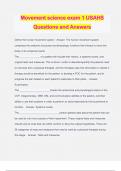
-
Movement science exam 1 USAHS Questions and Answers
- Exam (elaborations) • 18 pages • 2024
- Available in package deal
-
- $12.49
- + learn more
Movement science exam 1 USAHS Questions and Answers Define the human movement system - Answer- The human movement system comprises the anatomic structures and physiologic functions that interact to move the body or its component parts The _______________ of a patient will include their history, a systems review, and original tests and measures. This is done in order to describe/quantify the patients need for services from a physical therapist, and the therapist uses this information to de...
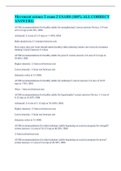
-
Movement Science II
- Package deal • 7 items • 2023
-
- $29.70
- + learn more
Movement Science 2 Exam 1 (with 100% accurate answers) Movement science 2 exam 2 USAHS (100% ALL CORRECT ANSWERS) Movement Science 2 Final Exam USA (A+ Graded already) Movement Science Exam 2 (complete solution offered) Movement Science II Final Exam (A+ Graded solution) Movement Science II Exam I USA (100% correct answers) Movement Science II Exam
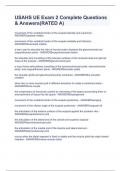
-
USAHS UE Exam 2 Complete Questions & Answers(RATED A)
- Exam (elaborations) • 11 pages • 2023
-
Available in package deal
-
- $9.49
- + learn more
movement of the vertebral border of the scapula laterally and superiorly - ANSWERSupward rotation movement of the vertebral border of the scapula medially and inferiorly - ANSWERSdownward rotation a term used to describe the ratio of normal motion between the glenohumeral and scapulothoracic joints - ANSWERSscapulohumeral rhythm the shoulder joint consisting of the articular surfaces of the humeral head and glenoid fossa of the scapula - ANSWERSglenohumeral joint a ring of bony artic...

-
Movement science exam 1 USAHS Questions and Answers 100% correct
- Exam (elaborations) • 12 pages • 2023
-
Available in package deal
-
- $18.49
- + learn more
Movement science exam 1 USAHS Questions and Answers 100% correct Define the human movement system The human movement system comprises the anatomic structures and physiologic functions that interact to move the body or its component parts The _______________ of a patient will include their history, a systems review, and original tests and measures. This is done in order to describe/quantify the patients need for services from a physical therapist, and the therapist uses this information ...
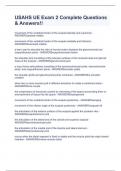
-
USAHS UE Exam 2 Complete Questions & Answers!!
- Exam (elaborations) • 11 pages • 2023
-
- $10.99
- + learn more
movement of the vertebral border of the scapula laterally and superiorly - ANSWERSupward rotation movement of the vertebral border of the scapula medially and inferiorly - ANSWERSdownward rotation a term used to describe the ratio of normal motion between the glenohumeral and scapulothoracic joints - ANSWERSscapulohumeral rhythm the shoulder joint consisting of the articular surfaces of the humeral head and glenoid fossa of the scapula - ANSWERSglenohumeral joint a ring of bony artic...
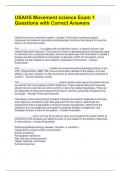
-
USAHS Movement science Exam 1 Questions with Correct Answers
- Exam (elaborations) • 12 pages • 2024
-
- $9.99
- + learn more
USAHS Movement science Exam 1 Questions with Correct Answers Define the human movement system - Answer-The human movement system comprises the anatomic structures and physiologic functions that interact to move the body or its component parts The _______________ of a patient will include their history, a systems review, and original tests and measures. This is done in order to describe/quantify the patients need for services from a physical therapist, and the therapist uses this informa...

-
Neuro Exam 1 USAHS Questions with complete solutions Graded A+
- Exam (elaborations) • 10 pages • 2023
-
Available in package deal
-
- $18.49
- + learn more
Neuro Exam 1 USAHS Questions with complete solutions Graded A+ Apraxia inability to make a motor plan, as a result of brain damage. Ataxia lack of muscle coordination Aphasia impairment of language, usually caused by left hemisphere damage either to Broca's area (impairing speaking) or to Wernicke's area (impairing understanding). 1 olfactory Making client smell something pleasant front of brain 2 optic thalamus - test visual acuity (Snellen chart, or # of ...
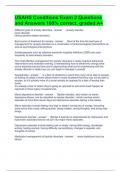
-
USAHS Conditions Exam 2 Questions and Answers 100% correct, graded A+
- Exam (elaborations) • 10 pages • 2023
-
Available in package deal
-
- $18.49
- + learn more
USAHS Conditions Exam 2 Questions and Answers 100% correct, graded A+ Different types of anxiety disorders anxiety disorder panic disorder various phobia-related disorders. Best course of treatment for anxiety Most of the time the best type of management for anxiety disorders is a combination of pharmacological interventions as well as psychological interventions Antidepressants such as selective serotonin reuptake inhibitors (SSRI) are used frequently to treat anxiety disorders ...
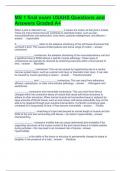
-
MS 1 final exam USAHS Questions and Answers Graded A+
- Exam (elaborations) • 11 pages • 2023
-
Available in package deal
-
- $18.99
- + learn more
MS 1 final exam USAHS Questions and Answers Graded A+ When a joint is referred to as ____________, it means the motion at that joint is limited. There are many factors that can contribute to restricted motion, such as pain, musculotendinous unit dysfunction, bony block, postural malalignment, and effusion. hypomobile A ________________ refers to the adaptive shortening of the soft tissue structures that surround a joint. This causes limited passive and active range of motion. contractu...
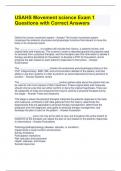
-
USAHS Movement science Exam 1 Questions with Correct Answers
- Exam (elaborations) • 12 pages • 2024
-
- $9.49
- + learn more
USAHS Movement science Exam 1 Questions with Correct Answers Define the human movement system - Answer-The human movement system comprises the anatomic structures and physiologic functions that interact to move the body or its component parts The _______________ of a patient will include their history, a systems review, and original tests and measures. This is done in order to describe/quantify the patients need for services from a physical therapist, and the therapist uses this informa...

How did he do that? By selling his study resources on Stuvia. Try it yourself! Discover all about earning on Stuvia


